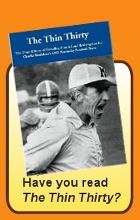
| about us |
about Blanton Collier |
news and events |
team physician's corner |
frank's dawg pound |
feedback | contact us |
Team Physician's Corner
Heat Illness
by Micheal B. Minix, Sr., M.D. http://www.cappaa.com
Promoting athlete’s safety is essential. Youth athlete injuries and heat illness have significantly increased during the last decade. Safe sports supervision and environments are imperative.
Coaching athletes in the 21st Century is unlike coaching them in the 20th Century, because today’s youth are different. First and foremost they are not as acclimatized to outside heat as athletes were 50 years ago, when central air conditioning wasn’t standard equipment, and indoor games and computers were non-existent. Athletes played outside many hours each day.
This fall before schools begin, youth athletes will begin conditioning and practicing for their fall schedules. Intense conditioning and practice will require replacement of water and salt because of loss from sweating.
The signs and symptoms are headache, dizziness fainting, weight loss, increased body temperature, thirst, muscle cramps, nausea and maybe seizures and unconsciousness.
Reference: American Academy of Pediatrics Committee on Sports Medicine, heat related illnesses are all preventable. (Sports Medicine: health Care for Young Athletes, American Academy of Pediatrics, 1991.)
"1. Each athlete should have a physical examination with a medical history when first entering a program and an annual health history update. History of previous heat illness and type of training activities before organized practice begins should be included. State High School Associations recommendations should be followed.
2. It is clear that top physical performance can only be achieved by an athlete who is in top physical condition. Lack of physical fitness impairs the performance of an athlete who participates in high temperatures. Coaches should know the physical condition of their athletes and set practice schedules accordingly.
3. Along with physical conditioning the factor of acclimatization to heat is important. Acclimatization is the process of becoming adjusted to heat and it is essential to provide for gradual acclimatization to hot weather. It is necessary for an athlete to exercise in the heat if he/she is to become acclimatized to it. It is suggested that a graduated physical conditioning program be used and that 80% acclimatization can be expected to occur after the first 7-10 days. Final stages of acclimatization to heat are marked by increased sweating and reduced salt concentration in the sweat.
4. The old idea that water should be withheld from athletes during workouts has no scientific foundation. The most important safeguard to the health of the athlete is the replacement of water. Water must be on the field and readily available to the athletes at all times. It is recommended that a minimum of 10 minute water breaks be scheduled for every half hour of heavy exercise in the heat. Athletes should rest in a shaded area during a break. Water should be available in unlimited quantities. Check and be sure athletes are drinking the water. Cold water is preferable. Drinking ample water before practice or games has also been found to aid performance in the heat.
5. Salt should be replaced daily. Modest salting of foods after practice or games will accomplish this purpose. Salt tablets are not recommended. Attention must be directed to replacing water - fluid replacement is essential.
6. Know both the temperature and humidity. The greater the humidity the more difficult it is for the body to cool itself. Test the air prior to practice or game using a wet bulb, globe, temperature index (WBGT index) which is based on the combined effects of air temperature, relative humidity, radiant heat and air movement. The following precautions are recommended when using the WBGT Index: (ACSM's Guidelines for the Team Physician, 1991).
| Below 64 - Unlimited activity |
| 65-72 - Moderate risk |
| 74-82 - High risk |
| 82 plus - Very high risk |
There is also a weather guide for activities that last 30 minutes or more (Fox and Mathews, 1981) which involves knowing the relative humidity and air temperature:
| Air Temp |
Danger Zone |
Critical Zone |
|---|---|---|
| 70° F | 80% RH | 100% RH |
| 75° F | 70% RH | 100% RH |
| 80° F | 50% RH | 80% RH |
| 85° F | 40% RH | 68% RH |
| 90° F | 30% RH | 55% RH |
| 95° F | 20% RH | 40% RH |
| 100° F | 10% RH | 30% RH |
RH= Relative Humidity
One other method of measuring the relative humidity is the use of a sling psychrometer, which measures wet bulb temperature. The wet bulb temperature should be measured prior to practice and the intensity and duration of practice adjusted accordingly. Recommendations are as follows:
| under 60° F - Safe but always observe athletes |
| 61°-65° F - Observe players carefully |
| 66°-70° F - Caution |
| 71°-75° F - Shorter practice sessions and more frequent water and rest breaks |
| 75°+ F - Danger level and extreme caution |
7. Cooling by evaporation is proportional to the area of the skin exposed. In extremely hot and humid weather reduce the amount of clothing covering the body as much as possible. Never use rubberized clothing.
8. Athletes should weigh each day before and after practice and weight charts checked. Generally a 3 percent weight loss through sweating is safe and over a 3 percent weight loss is in the danger zone. Over a 3 percent weight loss the athlete should not be allowed to practice in hot and humid conditions. Observe the athletes closely under all conditions.
9. Observe athletes carefully for signs of trouble, particularly athletes who lose much weight and the eager athlete who constantly competes at his/her capacity. Some trouble signs are nausea, incoherence, fatigue, weakness, vomiting, cramps, weak rapid pulse, visual disturbance and unsteadiness.
10. Teams that encounter hot weather during the season through travel or following an unseasonably cool period, should be physically fit but will not be environmental fit. Coaches in this situation should follow the above recommendations and substitute more frequently during games.
11. Know what to do in case of emergency and have your emergency plans written with copies to all your staff. Be familiar with immediate first aid practice and prearranged procedures for obtaining medical care, including ambulance service. Heat Stroke: This is a medical emergency - delay could be fatal. Immediately cool body while waiting for transfer to a hospital. Remove clothing and use cool water on body. An increasing number of medical personnel are now using a treatment for heat illness that involves applying either alcohol or cool water to the victim's skin and vigorously fanning the body. The fanning causes evaporation and cooling. (Source - the First Aider, September 1997) Heat Exhaustion: Obtain medical care at once. Cool body as you would for heat stroke while waiting for transfer to hospital. Give fluids if athlete is able to swallow and is conscious.
SUMMARY: The main problem associated with exercising in the hot weather is water loss through sweating. Water loss is best replaced by allowing the athlete unrestricted access to water. Water breaks two or three times every hour are better than one break an hour. The small amount of salt loss in sweat is adequately replaced by salting foods at meals. Talk to your medical personnel concerning emergency treatment plans.”


